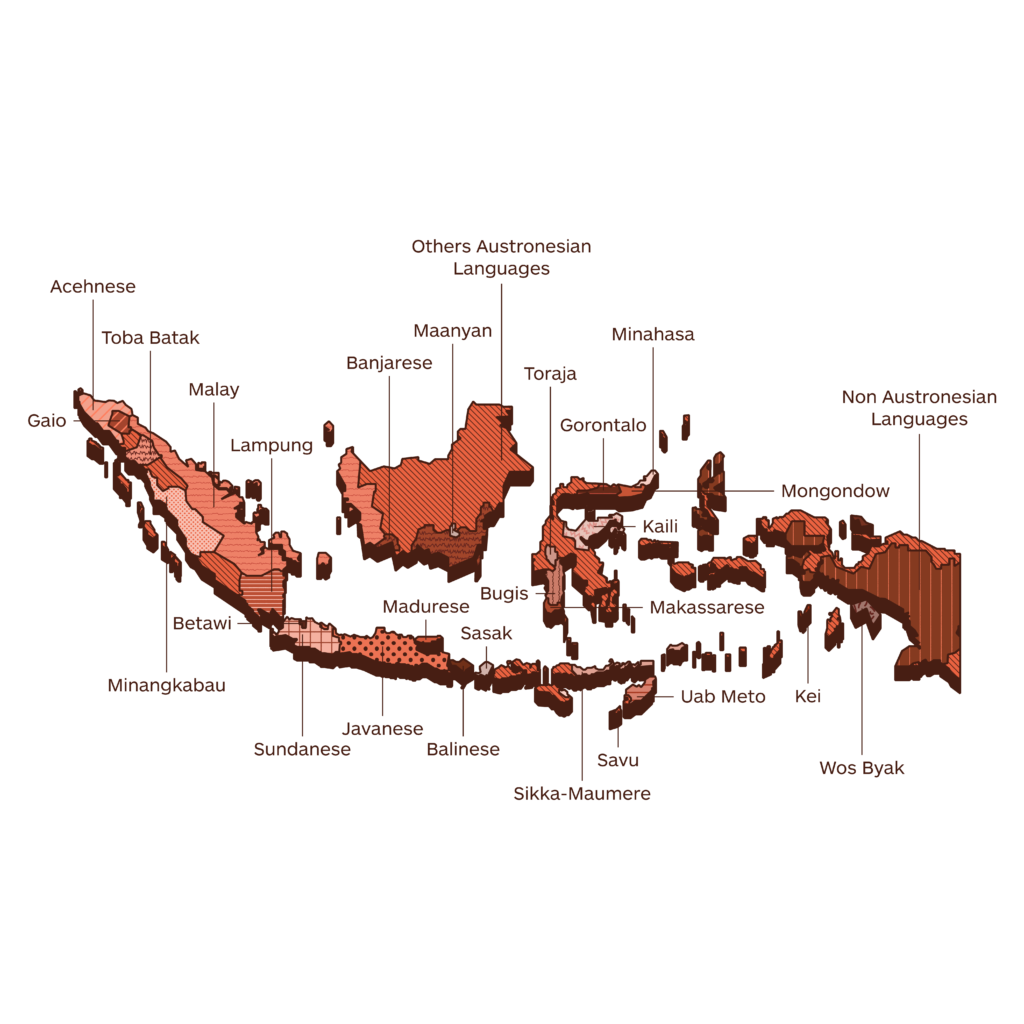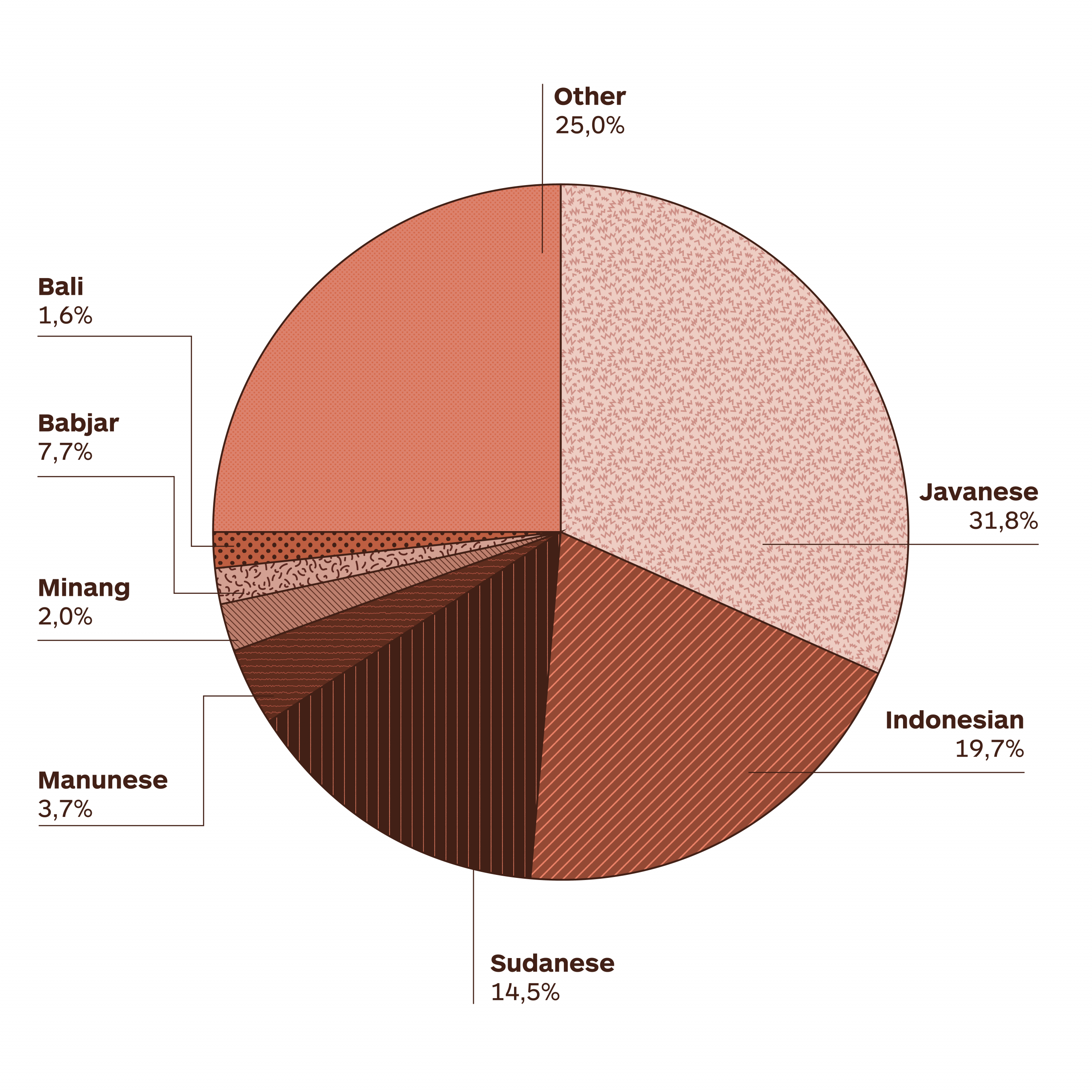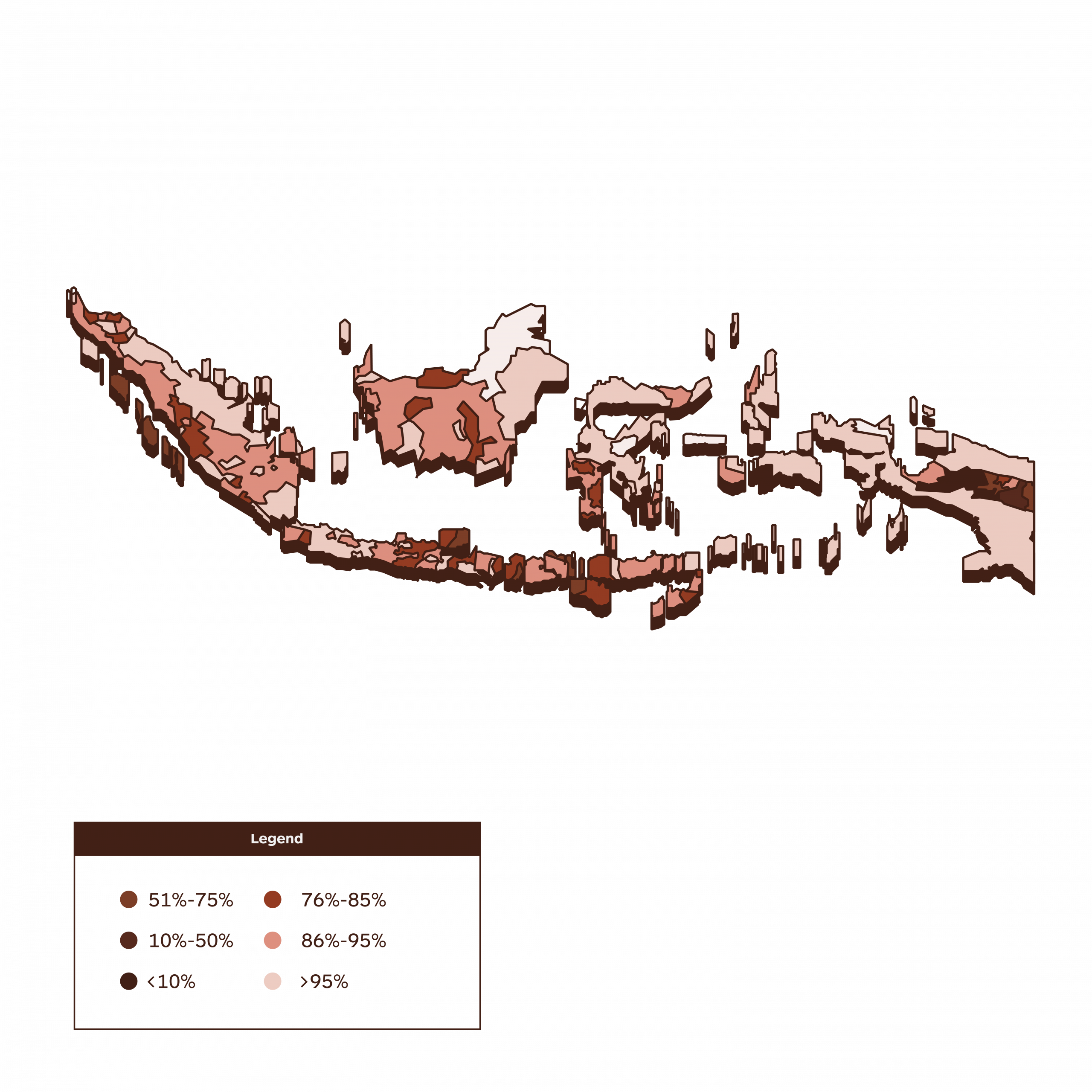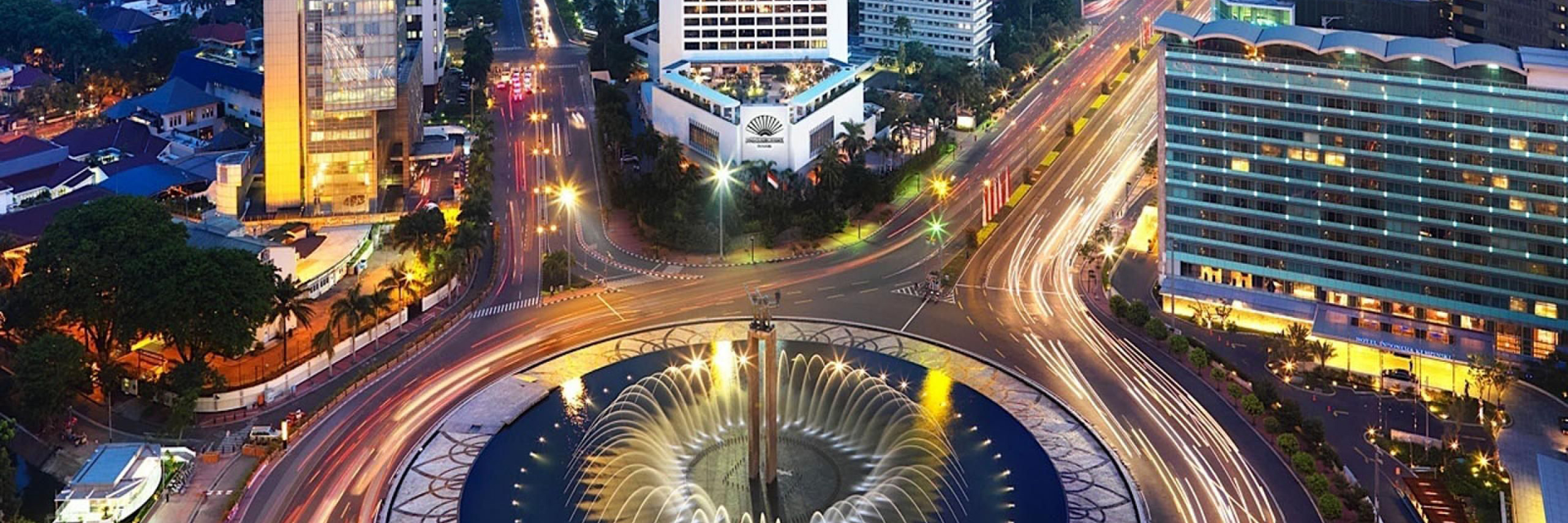Asia
To which language should you translate to localize in Indonesia?
What we know from our community
As one of the largest multilingual countries in the world, the linguistic landscape in Indonesia is extremely diverse and complex with many languages coexisting and influencing one another. Thus the existence of “Bahasa Indonesia” (which literally means “Indonesian language”) that serves as a unifying force for the country. It is estimated that around 85-90% of the population speaks Indonesian. It is used as the official language in education, government, and media.
But when it comes to how many Indonesians speak Bahasa Indonesia as their first language, the answer would be only less than a quarter of the population speak Indonesian as their primary language. It’s quite hard to give an exact percentage of language usage in Indonesia, since it’s a vast country and the language usage can vary greatly from region to region. In some areas, local languages are widely spoken, while in other areas, they may be used primarily in the home or in certain social contexts. And yet, most people speak their local languages as their mother tongue. In other words, many Indonesians are trilingual.
LANGUAGE INSIGHT
Official language
Bahasa Indonesia – Variant of the Malay language (12.1%; 34.02 mln)
Actual languages
Javanese (39.4%; 110.78 mln), Sunda (15.8%; 44.42 mln), Malay (12.1%; 34.02 mln), Madura (4.3%; 12.09 mln), Bugi (2.2%; 6.18 mln), Batak (2.1%; 5.90 mln), Banja (1.8%; 5.06 mln), Minangkabau (1.7%; 4.78 mln), Balinesian (1.4%; 3.93 mln), Chinese (0.4%; 1.12 mln), Papuan languages (0.1%; 281k), other (18.7%; 52.5 mln).
What the top 150 best localized websites in the world do in Indonesia
(Top 150 websites listed in the Global by Design ranking – published annually by Byte Level Research, this report provides a list of globally localized websites, showcasing best practices and emerging trends in their globalization)
- 67/150 localize by translating into Bahasa Indonesia
- 1/150 localizes by translating into Bahasa Indonesia and Simplified Chinese
- 1/150 localizes by translating into Bahasa Indonesia, Simplified Chinese, Hakka, Sindhi, Teochew and Indonesian Sign Language
- 1/150 localizes by translating into Bahasa Indonesia, French and Simplified Chinese
- 1/150 localizes by translating into Bahasa Indonesia, French, Simplified Chinese, Traditional Chinese, German, Spanish, Italian, Hungarian, Polish, Portuguese, Romanian, Turkish, Russian Japanese, Thai and Ukrainian
- 1/150 localizes by translating into both French and Simplified Chinese
- 1/150 localizes by translating into Simplified Chinese
-
3M
-
ABB
-
Accenture
-
Adidas
-
Adobe
-
Airbnb
-
Aldi
-
Amazon
-
American Airlines
-
American Express
-
Apple
-
Audi
-
Autodesk
-
Avis
-
Bayer
-
BMW
-
Booking.com
-
Bosch
-
British Airways
-
Bumble
-
Burberry
-
BYD
-
Canon
-
Capgemini
-
Cartier
-
Caterpillar
-
Chevrolet
-
Cisco Systems
-
Citibank
-
Coca-Cola
-
Costco
-
Dell
-
Deloitte
-
Delta
-
DHL
-
Disney+
-
Dyson
-
eBay
-
Eli Lilly
-
Emirates
-
Ernst & Young
-
Facebook
-
FedEx
-
Ford
-
Four Seasons
-
Fujifilm
-
GE
-
Gillette
-
GoDaddy
-
Google
-
Gucci
-
Haier
-
Heineken
-
Hermès
-
Hertz
-
Hilton
-
Hisense
-
Hitachi
-
Honda
-
Hotels.com
-
HP
-
HP Enterprise
-
HSBC
-
Huawei
-
Hyatt
-
Hyundai
-
IBM
-
IKEA
-
Intel
-
InterContinental Hotels
-
J&J
-
Jack Daniel's
-
Jehovah’s Witnesses
-
John Deere
-
Kellogg's
-
Kia
-
KPMG
-
L'Oréal
-
Land Rover
-
LEGO
-
Lenovo
-
Lexus
-
LG
-
Louis Vuitton
-
Lululemon
-
LUSH
-
Marriott
-
MasterCard
-
McDonald's
-
Mercedes-Benz
-
Merck
-
Microsoft
-
Mitsubishi Electric
-
Nestlé
-
Netflix
-
Nike
-
Nikon
-
Nintendo
-
Nio
-
Nissan
-
NIVEA
-
Oracle
-
Pampers
-
Panasonic
-
PayPal
-
Pepsi
-
Pfizer
-
Philips
-
Pitney Bowes
-
Porsche
-
Procter & Gamble
-
PWC
-
Revolut
-
Rolex
-
Royal Caribbean
-
Salesforce
-
Samsung
-
Sanofi
-
SAP
-
Sephora
-
Shopify
-
Siemens
-
Sony
-
Spotify
-
Starbucks
-
Steelcase
-
Stripe
-
Subaru
-
Tesla
-
The Church of Jesus Christ of Latter-day Saints
-
Tiffany
-
Tinder
-
Toshiba
-
Toyota
-
TripAdvisor
-
Uber
-
United Airlines
-
UPS
-
Visa
-
Volkswagen
-
Volvo Cars
-
Vrbo
-
Walmart
-
Western Union
-
Wikipedia
-
Wise
-
WordPress
-
Workday
-
Xerox
-
Xiaomi (Mi)
-
Zara
-
Zoom
If you need others information, below you can find a selection of economic/social/cultural data
Overview
Language
Official language
Indonesian 29%
Secondary languages
Javanese 52%, Sundanese 19%
T-index
1%
T-Index ranks countries according to their potential for online sales.
Other languages
More than 700 living languages are spoken in Indonesia
English
Low proficiency (EF) – 80 of 116 countries/regions in the world- 12/23 position in Asia.
Demography
Capital: Jakarta
Currency: Indonesian rupiah
Population: 281.190 mln
Population density: 147/km2
Economy
GDP: 1.37 trillion USD (2023)
GDP per capita: 4,876.3 USD (2023)
Exports: $320 billion (2022)
Statistics
Internet users: 66.5% penetration, 185.3 million
Unemployment rate: 3.3% (2023)
Urbanisation: 59% (2023)
Literacy: 96% (2020)
Conventions
Numbering system
Arabic numerals with comma as decimal separator.
Date format: dd-mm-yyyy
Time: 24h time system
Country code: 0062
Language data sources: Worldatlas/Britannica//EF/Wikipedia; Demography data sources: IMF/Worldometers; Conventions data source: Wikipedia; Economy data sources: WTO/OEC/CIA/Esomar/Datareportal; Statistics data sources: Datareportal/WorldBank/UN/UNESCO/CEIC/IMF/Culturalatlas/Commisceoglobal
Facts and data
Economy
Imports
$230 billion (2022). Refined Petroleum ($23.2B), Crude Petroleum ($10.1B), Petroleum Gas ($4.92B), Motor vehicles; parts and accessories (8701 to 8705) ($4.19B), and Broadcasting Equipment ($4.01B), importing mostly from China ($71.3B), Singapore ($22.5B), Japan ($14.9B), Malaysia ($12.5B), and Thailand ($10.4B).
In 2022, Indonesia was the world’s biggest importer of Soybean Meal ($2.92B), Raw Sugar ($2.37B), Other Large Iron Pipes ($591M), Industrial Furnaces ($474M), and Steam Boilers ($427M).
Financial inclusion factors (over 15 years of age)
• 50.5% have an account with a financial institution
• 1.6% have a credit card
• 9.3% have a mobile money account
• 5.9% make online purchases
Ease of doing business
It is easy to conduct business (rated 69.6 out of 100) ranked 9th out of 25 East Asia-Pacific countries and ranked 73rd out of 190 countries worldwide (2023, World Bank).
Global Innovation Index
Ranked 12th out of 16 South-Eastern
Asian and Oceanic countries, 61st out of 132 worldwide.
The Global Innovation Index captures the innovation
ecosystem performance of 132 economies and tracks the most recent global innovation trends.
Exports
$320 billion (2022). Coal Briquettes ($50.8B), Palm Oil ($28.7B), Ferroalloys ($13.7B), Petroleum Gas ($11.8B), and Copper Ore ($8.89B), exporting mostly to China ($67.7B), United States ($31.6B), Japan ($26.6B), India ($25.3B), and Malaysia ($15.6B).
In 2022, Indonesia was the world’s biggest exporter of Palm Oil ($28.7B), Ferroalloys ($13.7B), Lignite ($8.29B), Stearic Acid ($6.84B), and Nickel Mattes ($6.27B).
Main local online stores
MercadoLibre, eBay and Amazon, Netshoes, Alibaba, Garbarino.com, Musimundo.com, Frávega, Apple and Cencosud
Economic freedom
‘Moderately free’ (rated 63.5 out of 100) ranked 10th out of 39 Asia-Pacific countries and ranked 53rd out of 184 countries worldwide (2024, Heritage Foundation and Wall Street Journal).
Economy data sources: WTO/OEC/CIA/Esomar/Datareportal

Indonesia. The wandering whispering.
By Rachmadhina Insan Widyapianissa
At 1,905 million square kilometers with over 275 million people, Indonesia is really a big – both figuratively and literally. Indonesia has 34 provinces, 17,000 islands, and 700 living local languages spoken across the archipelago.
Read it nowService Imports (2020)
Service Exports (2020)
Source: OEC
Trade balance of goods from 2012 to 2022
Source: Statista
Historical Data Trade Imports
The following section uses historical trade data imports from partners of Indonesia.
Historical Data Trade Exports
The following section uses historical trade data exports from partners of Indonesia.
Source: OEC
The Top Export Opportunities for Indonesia by Relatedness
Relatedness measures the distance between a country's current exports and each product by showing only products that Indonesia is not specialized in.
Indonesia's Most Complex Exports
The Product Complexity Index (PCI) measures the knowledge intensity of a product by considering the knowledge intensity of its exporters.
Source: OEC
Indonesia's Most Specialized Products
Specialization is measured using Revealed Comparative Advantage (RCA), an index that takes the ratio between Indonesia observed and expected exports in each product.
Source: OEC
Perception of products made in selected countries in 2017
Source: Statista
Which attributes do you associate with products made in Indonesia?
Source: Statista
Market Growth Imports (2020)
This score represents the likelihood that the given country will start importing that product in the next few years. It forecasts the opening of a new specific market.
Market Growth Exports (2020)
This score represents the likelihood that the given country will start exporting that product in the next few years. It forecasts the opening of a new specific market.
Source: OEC
Foreign direct investment, net inflows (% of GDP)
Source: OEC
Distribution of e-commerce payment methods in Indonesia in 2019
Source: Worldpay

T-index
Reach most of the online purchasing power
T-Index ranks countries according to their potential for online sales. It estimates the market share of each country in relation to global e-commerce.
Try it nowMedia
Media language Indonesian, English
Information channels
Television is the most popular medium. Major national commercial networks compete with state-owned Televisi Republik Indonesia (TVRI). The radio dial is crowded, with scores of stations in Jakarta alone. In line with global trends, print newspaper circulations are falling. Reporters Without Borders (RSF) describes as “drastic” the restrictions on media access to the troubled province of West Papua. More generally, it says many journalists self-censor because of the threat from laws on blasphemy and online libel. The authorities can resort to blocking online content deemed to break the law or violate social norms, says Freedom House. The NGO reported restricted access to social media and manipulation of online content during elections in 2019.
The press
The Jakarta Post – English-language daily
Kompas – daily
Pos Kota – daily
Indo Pos – daily
Republika – daily
Bisnis Indonesia – daily
Tempo – weekly
Television
Televisi Republik Indonesia (TVRI) – state-owned, operates two networks
Surya Citra Televisi Indonesia (SCTV) – private
Rajawali Citra TV Indonesia (RCTI) – private
Indosiar – private
MNCTV – private
Trans 7 – private
Metro TV – private, news
Radio
Radio Republik Indonesia (RRI) – state-owned, operates national, regional and local stations
News agency
Antara – government-owned news agency, English-language pages
Jakarta Globe – news site, in English
Detikcom – news site
Media data source: BBC
Internet Data
Internet users
66.5% penetration, 185.3 million.
Share of web traffic by device
62.83% mobile phones, 36.83% computers (laptops and desktops), 0.34% tablet devices.
Median speed of mobile Internet connection
24.53 Mbps
Median speed of fixed Internet connection
28.34 Mbps
Mobile connection as a percentage of total population: 126.8%
Percentage of mobile connections that are broadband (3G-5G): 95.5%
Most popular web search engines
Google (94.6%), Bing (1.86%), Yahoo! (1.53%), Yandex! (1.02%), DuckDuckGo (0.94%), other (0.05%).
Most used social media
Facebook (58.94%), YouTube (34.6%), Instagram (4.83%), Twitter (1.16%), Pinterest (0.32%), VKontakte (0.06%), LinkedIn (0.04%), other (0.03%).
Internet data sources: Datareportal/Statcounter
Social statistics
Life expectancy
68 years (2022)
Current education expenditure
88.1% of total expenditure in public institutions
Current health expenditure
3.71% of GDP
Cultural Curiosities
Indonesia’s geography, composed of 17,500 islands, means that there are over 300 different ethnicities, and this has led to the development of many micro-cultures with their own customs and traditions.
A common trait is a hierarchical structure that most Indonesians follow, with age usually the overriding feature in determining the level of respect. The elderly are thought to have the most wisdom and are thus considered deserving of more authority.
Graduates
In 2017, about 16% of 25–64 year-olds in Indonesia had attained tertiary education, well below the OECD average of 44% and the G20 average of 38% (Figure 1). Bachelor’s programmes are the most popular form of tertiary education among young adults in Indonesia: 12% of 25–34 year-olds have earned a bachelor’s degree, compared to 4% for short-cycle tertiary qualifications. Not many young adults will graduate from a master’s or doctoral degree in Indonesia: only 1% have attained a master’s degree and below 0.01% a doctorate (OECD averages: 14% and 0.8%).
Corruption perceptions Index
Indonesia scored 34 out of 100, ranked 110 out of 180 countries worldwide.
CO2 emissions
2.1 metric tons per capita
World Happiness Index
Indonesia ranked 87 out of 146 countries, with a score of 5.240.
Social statistics sources: WorldBank/UN/UNESCO/CEIC/IMF
Country Curiosities
Bahasa Indonesia is the 11th most spoken language in the world, with over 270 million speakers. The term “bahasa” means “language,” but Bahasa Indonesia refers specifically to the official language of Indonesia. It’s also a second official language in Vietnam, alongside English, French, and Japanese, since 2007. Known for its simplicity and phonetic nature, Bahasa Indonesia plays a key role in unifying the diverse people of Indonesia and Southeast Asia.
Additionally…
- Indonesia is the 2nd most linguistically diverse country, with 700+ languages spoken.
- It’s the world’s largest archipelago, with 17,508 islands, and it’s the last archipelago state in the world.
- It’s the 4th most populous country worldwide, with over 250 million people.
- A flourishing democracy, rated the freest in Southeast Asia by Freedom House.
- Indonesia’s GDP exceeds US$1 trillion, making it an ASEAN powerhouse.
- Java is the world’s most populous island, home to 140+ million people.
- Indonesia hosts the world’s largest gold mine.
- With 165 million under 30, Indonesia has the world’s largest youth population.
- Indonesia was the first developing country to launch its own satellite system (1976).
- Positioned between Asia and Oceania, Indonesia is a transcontinental country.
The Data Factbook is a work in progress project. Our community is helping us to fill it up always with new and updated data. Your contribution is precious. If you want to help us, please write your advices at imminent@translated.com
Languages research
Languages spoken in Indonesia

Legend
-
Acehnese
-
Toba Batak
-
Malay
-
Lampung
-
Madurese
-
Sasak
-
Banjarese
-
Maanyan
-
Others Austronesian Languages
-
Bugis
-
Toraja
-
Gorontalo
-
Non Austronesian Languages
-
Minahasa
-
Mongondow
-
Kaili
-
Makassarese
-
Uab Meto
-
Kei
-
Wos Byak
-
Savu
-
Sikka-Maumere
-
Balinese
-
Javanese
-
Sundanese
-
Beati
-
Minangkabau
Languages in percentages

Bahasa Indonesian

The geographical distribution of languages that you will find in the maps published in this section is a work in progress. Our community is helping us to fill it up with always new and updated data. Your contribution is precious. If you want to help us, please write to imminent.factbook@translated.com
Photo credit: Ruben Hutabarat, Unsplash


